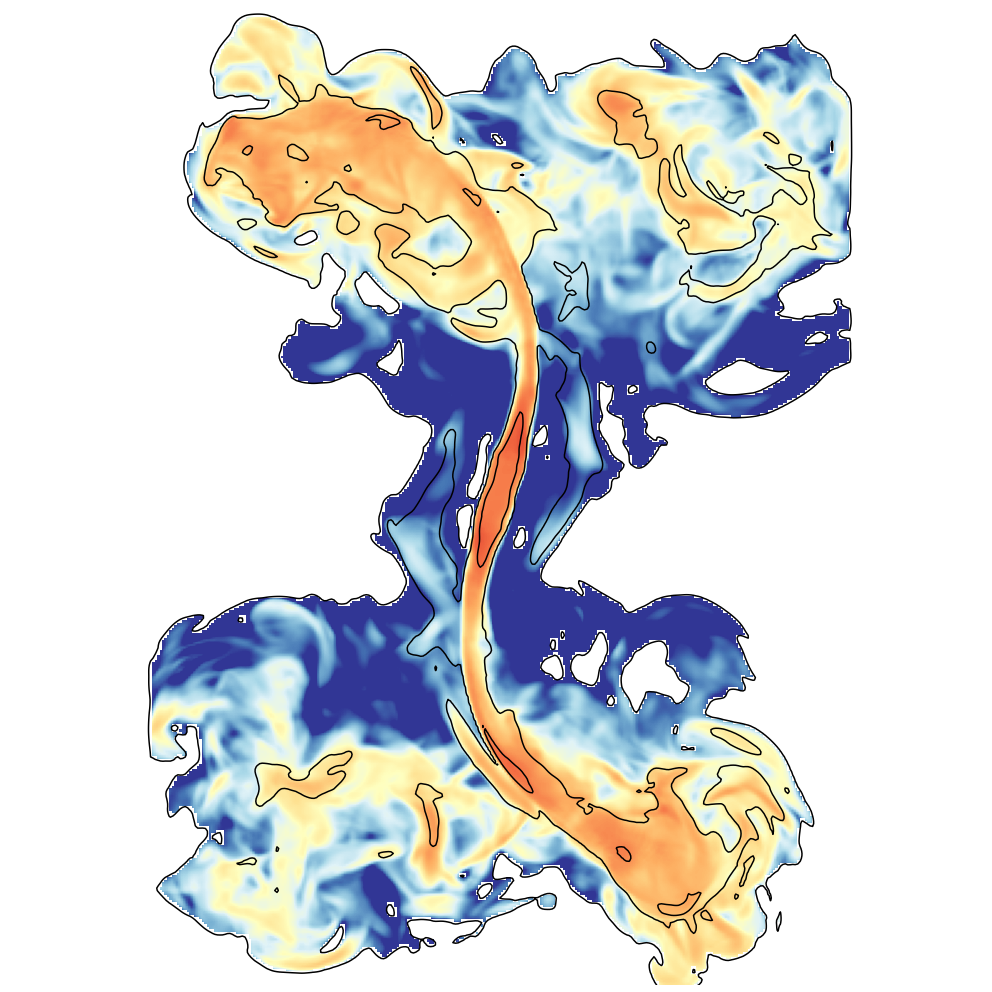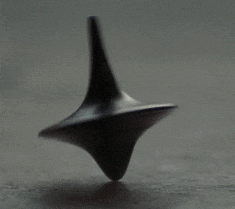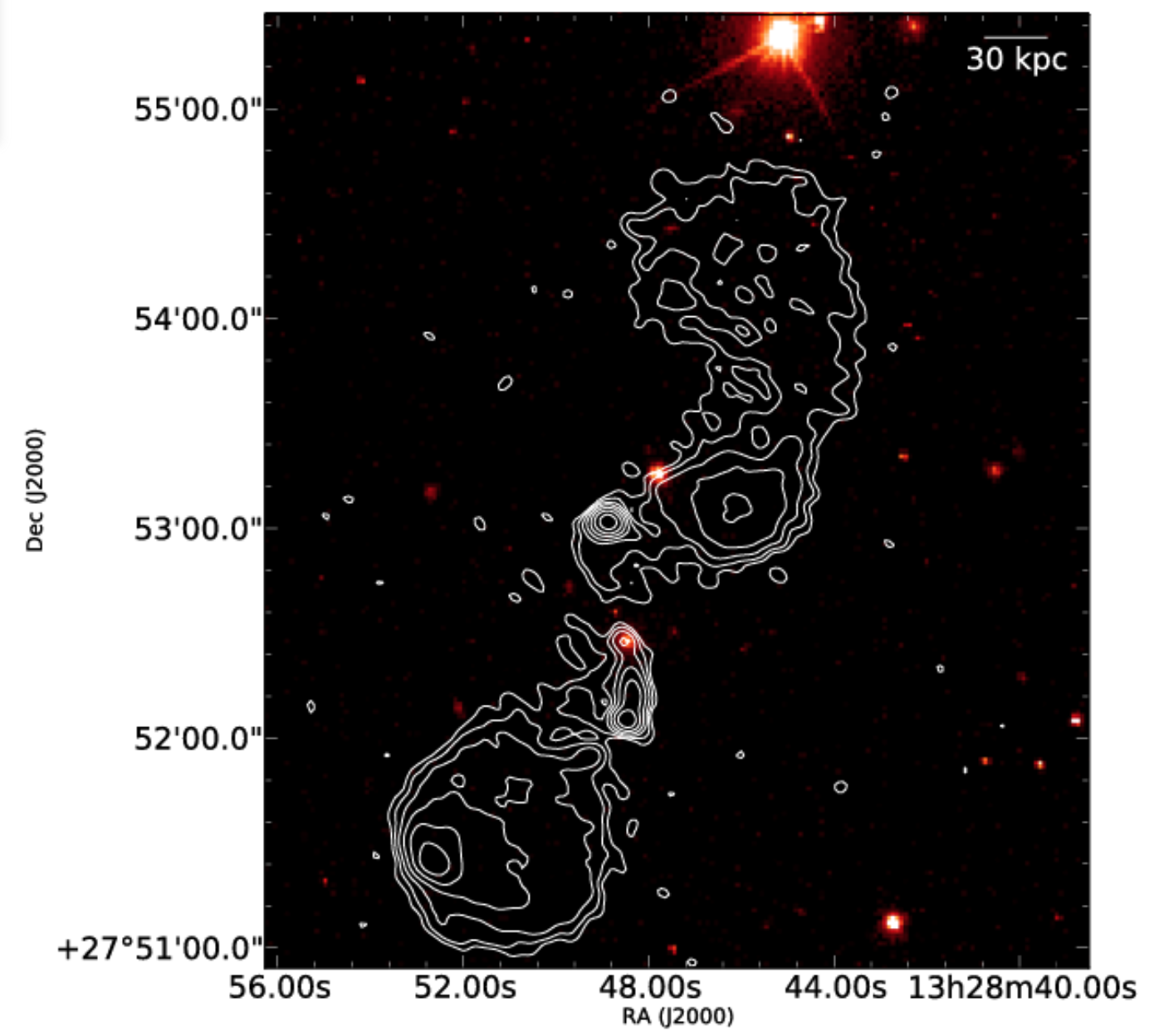Radio galaxies are diffuse radio structures that can be millions of light years in size. They are created by powerful magnetized jets full of high energy particles launched from the supermassive black holes at the centers of galaxies. Due to the physics of the launching of these jets, we normally expect them to be bilaterally symmetric, with two oppositely directed jets leading away from the galactic center. A classic example would be Cygnus A, one of the brightest and most well studied radio galaxies:
Cygnus A is a classic “FRII” radio galaxy. The active galactic nucleus can be seen as a hot spot in the center of the image with two oppositely directed jets leading away. These jets deposit massive amounts of energy in the radio “lobes” to either side of the host galaxy, which leads to the emission we observe. Image credit: NRAO/AU
However, nature isn’t always so simple, and there are many oddly shaped radio galaxies. Some are bent backwards (as if pushed on by a strong wind) into “U” shapes as they interact with the surrounding intracgalactic medium. Others have highly distorted morphologies that are hard to understand. One class of radio galaxy, sometimes called “S-shaped” (or sometimes X or Z-shaped, depending on their morphology), makes up about 10% of extended radio galaxies. Understanding the shapes of these sources often relies not on some external dynamics, but instead on the assumption that the trajectory of the jets when they are launched is not constant, as is likely the case for Cygnus A. These jets may precess, like a top that is about to fall over, wobbling in circles.
Precession of a top
The cause of precession of a radio jet is an open question, with multiple possible physical answers. Maybe the disk of material orbiting the supermassive black hole is precessing due to general relativistic effects. Maybe there is a secondary supermassive black hole in the system due to a recent galaxy merger and it is causing the precession. Whatever the answer, there are clearly radio sources which seem to be precessing for one reason or another.
J1328+2752, a possible precessing radio jet from Nandi et al. 2021.
We wanted to help radio astronomers better understand these sources, so we undertook a simulation study of precessing jets. Our focus, as is often the case, is on the observable properties of these sources, so today we’ll show off a lot of synthetic radio images (and movies!) of the simulated jets. We can make these images because in addition to solving the magnetohydrodynamic equations to find the dynamical evolution of the jets (their density, pressure, magnetic fields, etc.), we also include a population of high energy electrons in the jet. We solve the equations of their energy evolution as they expand and contract, radiate away energy, and get accelerated again at shocks. As they interact with the simulated magnetic fields, they radiate in the radio band and emit the radiation that allows us to see the “radio galaxy” to begin with. This is the emission that we’ll show here.
To start, we inject our jet in s cylindrical region inside the simulation volume. This jet injection cylinder is then rotated slightly every time we update the simulation so that over time it rotates in circles, just as the spinning top does.
A simple diagram of the jet precession setup. The jet launching cylinder is rotated each time step such that it completes one precession every few million years (simulated time). This “precession period” is varied between different simulations. The angle between the jet and the axis around which it precesses is called the precession angle ψ, which is 30° in this image, and is also varied between simulations.
We completed a parameter study varying both the precession angle (how wide the precession is) and the precession period (how long it takes to precess). There were a lot of interesting changes to the resultant jet morphology, radio brightness, and radio spectral properties of these jets. We’ll leave many of the details for readers to follow up in the published article, but focus on a few things here.
Synthetic radio images from the simulated jets. The 1st, 2nd, 4th, and 5th column show the radio spectral index, a measure of how much energy the plasma has lost to radiation, with black contours representing how bright the structures are at 300MHz. The 3rd column shows the radio brightness distribution at 300MHz. Columns 2, 4, and 5 show the simulations all at the same time of 96 million years into the simulations, while columns 1, 3, and 5 show each simulation just as the jets have completed one full rotation (one precession period). The precession angle varies with each row, with angles (row 1: 10°, 2: 20°, 3: 30°, and 4: 45°).
As you change the precession period and angle, there were striking differences between the jets. One was that for shorter precession periods, generally the jets were brighter and had “flatter” spectra (meaning they showed less signs of losing energy to radiation, red or orange in the figure). This was because high energy electrons take some time (in this case at least 10s of million up to maybe 100 million years) to lose a significant amount of energy to radiation, so they don’t have time to “cool” before fresh electrons from the jet are again deposited in the same region of space. This keeps the emission bright and “flat.” When the precession period is long, the jet takes much longer to come around again to the same direction and so electrons have much more time to cool before being refreshed with new electrons, so these jets show regions with lower surface brightness and “steep” (blue in the figure) spectra with signs of radiative losses.
As the precession angle varied, we also note interesting changes to the jet structures. With small precession angles, the jets are oriented such that their momentum is mostly aligned with the jet precession axis, and so the jet is more able to propagate in that direction and the low density jets are able to carve out elongated cavities. Once these cavities are created, the jets propagate freely through them without depositing any new jet material, so the cavities themselves radiatively age, becoming lower brightness and spectrally steeper. In contrast, larger precession angles force the jet momentum to be spread over a wider area and ever changing direction, so the jets are not able to expand outward as far from the host and the cavities they carve out have lower axial ratios (in the limit they are nearly spherical). For large precession angle and small precession period, the resultant structures are less like a collimated jet and more like isotropic energy injection.
One of the most important things we wanted to study was related to what astronomers call “projection effects.” This is about how a three dimensional structure can appear different when viewed from different angles when there is little to no information about the distance along the line of sight, as is often the case in astronomy.
This movie shows the same simulation from 12 different angles simultaneously. If you pause it at any time, you’ll see a variety of morphologies to the jets. Sometimes you will see a clear “S-shape” to the jet, while other times it is difficult to see any hint of precession. Sometimes the jet appears nearly straight, and others you cannot see the jets at all, as they are pointed directly towards or away from the observer. These are all situations that radio astronomers have to consider when looking at their observations, and simulations like these, and this kind of movie can be of help to them better understanding the structures they see and how they might have evolved to the point at which they were observed.
A few interesting dynamical features were also stumbled upon during this work. One of them was what we are calling “jet reorientation events.” This movie shows one such event:
During a jet reorientation event, the trajectory of the jet changes very rapidly, and the jet goes from being bent backward by its interaction with the denser surrounding medium, to being relatively straight and propagating farther out. This occurred in our simulations after about one precession period. To understand why this occurs, we have to think about why the jet bends backward as it rotates around in the first place. The space between galaxies is not empty, but filled with a low density plasma called the intragalactic medium. Despite its low density, this medium is still denser than the jet plasma. This means from the perspective of the jet, there is a strong “wind” pushing against it as it moves through the medium, which causes it to bend backward. When the jet completes one precession period and runs into the low density gas it left behind previously, the strength of that “wind” is reduced and so is the pressure causing it to bend. It then straightens out and quickly propagates through this low density cavity until it hits the higher density intragalactic medium on the other side.
Another interesting result of this work relates to a recent discovery in radio astronomy. So called “Odd Radio Circles” (a.k.a. ORCs) have been discovered in the last 2-3 years and remain somewhat of a mystery, hence their name. These are low surface brightness, spectrally steep sources, but make nearly uniform rings. Some of them may have an associated galaxy near their center, but not all. We aren’t even sure how far away they are, so it is difficult to gauge their true physical size.
MeerKAT radio image of ORC1 superimposed with optical data from the Dark Energy Survey, taken from Norris et al. 2022
One possible formation mechanism that has been proposed previously was that these are the remnants of radio galaxy lobes seen end-on. Our simulations may lend some support to that, or even possibly modify it to relate more specifically to precessing radio jets.
In this movie, a simulated precessing jet is seen from above the precession axis. At t=100 million years, the jets turn off and the radio emission begins to fade as the electrons lose energy. At some point after a few million years later, there is a ring of emission that resembles an ORC. This may help radio astronomers better understand these types of sources.
To learn more, check out the published article!







